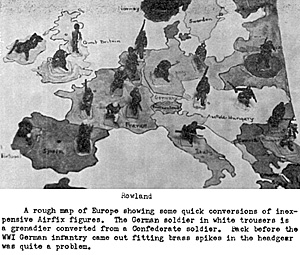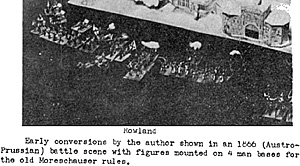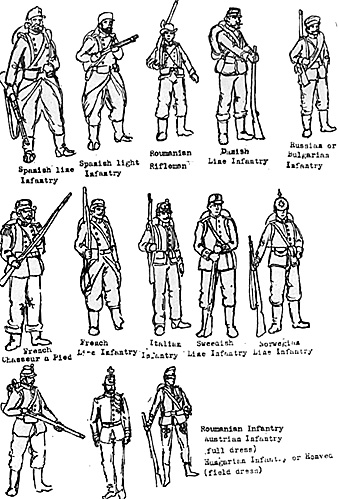
The late 19th century found Europe in a state of armed truce and increasing national wealth. New weapons mass produced by a new technology were available to equip larger armies recruited from increased populations.
The effect of the new weapons on tactics, however was not fully appreciated, and the national armies for the most part retained brilliant uniforms of distinctive colors. The English red, French and German blue, Russian Green, Bulgarian white uniforms were only a few of the colors of the European rainbow.
For the beginning wargamer, or the old hand who is fond of adding armies to his collection, this period has quite a lot to offer. The diplomacy of the period, while successful in averting calamity until 1914, suggests many possible game situations, while the technological changes, ranging from the rifled musket to the magazine rifle offer several distincly different rule periods (if one is willing to overlook some fashion changes) with the same basic armies.
Perhaps more important, however, is the fact that figures in the basic uniform styles of the period, subject to use for various national armies, are readily available to the collector or wargamer at low cost.
For example, Germany infantry in the 1914 auftarschieren uniform is available from Airfix, Scruby, and some other manufacturers in 20-25mm scales may be painted in the following ways:
British
RM coat with white belting and dark blue gray trousers for the line infantry, with cuff, collar, and button distinctions according to regiment. Dark green coat and trousers for the rifle regiments, with black belting.
German
Dark Prussian blue tunic with dark gray trousers and black belting will do for most Prussian line units, with various cuff, collar, buttons and trouser stripe distinctions by regiment.
Bavarian units wore light blue uniforms with red collar tabs, shoulder tabs, and piping for the line and green for the Jager (light) battallions.
A large gold eagle appeared on the helmet front.
Norwegian
Light blue uniform, white trimmed shoulder tab, Silver sunburst on helmet front, silver spike, red piping around jacket collar, and down trouser leg, black belting.
Portugese
Medium brown tunic with white trousers and black belting for the line, with red collar and cuffs. The cacadores (light) had no cuffs, and wore blue trousers. The figure in soft cap from the Airfix WWI German infantry, or the WWI British infantry from any source will make up into Russian infantry with a dark green buttonless tunic and gray trousers with various collar and cuff colors. Some metal figures are cast with the bandolier style blanket roll but the only way to do a really accurate job in plastics is to graft the British WWI head to the Russian WWII body. Depending on the degree of "Artistic liscence" the job is harder or easier, since putees will have to be gloss painted into boots if the British figures are used.
Bulgarian
Bulgarian infantry is in a uniform of similar cut to the Russian, and has the same difficulty with the blanket roll, Coat and trousers are white with piping and hat band yellow for summer. In winter a dark green uniform with a short fur cap was worn. The latter may be abstracted from rifle bearing "commando figures" from Airfix.
 Other European powers continued in the earlier French style with tunic often being reserved for full dress (use union infantry, or Scruby chasseurs a pied) with the capote being worn in the field(Airfix: legionairres Scruby French infantry and legionary types.)
Other European powers continued in the earlier French style with tunic often being reserved for full dress (use union infantry, or Scruby chasseurs a pied) with the capote being worn in the field(Airfix: legionairres Scruby French infantry and legionary types.)
Austrian
Austrian infantry is best done in full dress with wings painted in gloss paint by unit colors on a union infantry figure, kepi gloss black with gold badge in front. Hungarians are best done in the field uniform from the WWII Japanese figures in soft cap with yellow Hungarian knots on the trousers (red for reserve, or honved units). The coat is dark blue, trousers light blue in either case,
Spanish
Spanish light infantry wore almost an identical uniform to the French foreign legion, but with light brown foot coverings and dark gray leggings. The coat is also usually shown somewhat darker than the late 19th century French capote. Line units, however, ever, have a peaked cap similar to the one worn by the Austro-Hungarian forces in the field. These may be grafted from Afrika Corps or Japanese figures, shaved down from the Foreign legion, though a more artistic job can be done on metal figures with a file.
Roumanian
Roumanian infantry wore a dark blue coat with dark gray trousers striped red with collar, cuffs, pompon and band of the kepi in red. The kepi itself is dark blue, blanket roll on pack tan, greatcoat (rolled on top of blanket) gray. The Roumanian sharpshooters wore a brown jacket with collar and cuffs trimmed green, grey trousers with green stripe, and a brimmed hat with a small green tuft on the right side. Boots and belts were black.
Swedish
Swedish infantry wore an almost Prussian blue uniform with trim on the collar and cuffs yellow, as on the kepi. boots and belting black except for the belt from right shoulder across body, which is of a light color, apparently either white or light tan from old color prints.
Danish
Danish infantry wore a dark blue coat with red collar tabs. cuff trim, and piping down the front of the jacket edging the left flap of the coat. The kepi is trimmed in red.
Italian
Italian infantry had a shorter than usual coat, which conforms more closely to the coats of the Airfix Civil War figures, no boots, but short white spats under the trousers. The coat, again, was dark blue with red trim, trousers light blue with red stripe, kepi dark blue with silver star in front, trimmed with red cording an stripe around the top.
French
French infantry in the field wore the long coat (light blue) with dark red collar tabs, trousers, and kepi, the bottom band and trim of tit kepi being blue. Light infantry, or chasseurs a pied, had dark blue coats with green epaulettes trimmed yellow, dark blue kepi, yellow striping on trousers coat and kepi.
Needless to day, this article does not exhaust the uniforms of European infantry in the late 19th century (these being about 1890) but it may provide some color schemes useful to the reader.
Cavalry and artillery to go with the infantry will be covered in the next two issues.
In painting and converting flexible plastic figures, Airfix, Marx, or others, it is adviseable to use Humbrol paints. We finally talked one of our local dealers into getting the stuff for just that purpose. Years ago, while I was complaining about the high chip and peal rate of paints on flexible plastics, a friend reached into a box and produced a flexible plastic truck top. He had painted it tan with Hubrol, and, as he twisted and turned the thing in his hands, it stayed painted.
Of course, not every figure painted with Humbrols will keep its paint for a lifetime. An English friend once commenited that Humbrols peeled almost as easily as other brands if applied too thickly. Carefully applied, however, with the brush occassionally dipped in thinner, Humbrols will hold onto plastics quite wall through normal handling.
If you strongly prefer the brush handling or tonal quality of other types of paint, try Humbrol flat white as a primer coat, and once it has dried, apply your usual paints.

More Colorful Militarism
- Colorful Militarism Part 1: Infantry
Colorful Militarism Part 2: Cavalry
Colorful Militarism Part 3: Artillery
Back to The Armchair General Vol. 1 No. 1 Table of Contents
Back to The Armchair General List of Issues
Back to MagWeb Master Magazine List
© Copyright 1968 by Pat Condray
This article appears in MagWeb (Magazine Web) on the Internet World Wide Web. Other military history articles and gaming articles are available at http://www.magweb.com
